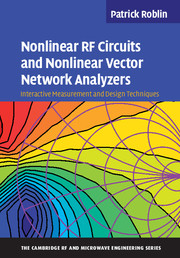 Nonlinear RF Circuits and Nonlinear Vector Network Analyzers
Nonlinear RF Circuits and Nonlinear Vector Network Analyzers Book contents
- Frontmatter
- Contents
- Preface
- Dedication
- Acknowledgments
- 1 Wireless signals
- 2 Large-signal vector measurement techniques with NVNAs
- 3 Device modeling and verification with NVNA measurements
- 4 Characterization and modeling of memory effects in RF power transistors
- 5 Interactive loadline-based design of RF power amplifiers
- 6 Behavioral modeling
- 7 Kurokawa theory of oscillator design and phase-noise theory
- 8 Design, modeling, and linearization of mixers, modulators, and demodulators
- 9 Linearization of RF power amplifiers with memory
- Index
- References
9 - Linearization of RF power amplifiers with memory
Published online by Cambridge University Press: 05 July 2011
- Frontmatter
- Contents
- Preface
- Dedication
- Acknowledgments
- 1 Wireless signals
- 2 Large-signal vector measurement techniques with NVNAs
- 3 Device modeling and verification with NVNA measurements
- 4 Characterization and modeling of memory effects in RF power transistors
- 5 Interactive loadline-based design of RF power amplifiers
- 6 Behavioral modeling
- 7 Kurokawa theory of oscillator design and phase-noise theory
- 8 Design, modeling, and linearization of mixers, modulators, and demodulators
- 9 Linearization of RF power amplifiers with memory
- Index
- References
Summary
One of the most challenging issues in designing RF power amplifiers is the linearity requirement. The spurious emissions from nonlinear RF power amplifiers are spread out over neighboring channels. As more complex wideband modulation techniques such as wideband CDMA and OFDM are used and also combined in multi-carrier and even multiband transmitters, higher peak-to-average power ratios (PAPRs) (e.g. 4.5 dB for a handset and 12 dB for a basestation in WCDMA) result, imposing stronger linearity requirements on RF PAs. Memory effects also become more significant in highefficiency PAs operating with wideband signals and need to be taken into account for their linearization. As we shall see, memory effects can be classified into two main types: slow memory effects and fast memory effects [1] [2]. Slow memory effects, which usually encompass temperature effects [3], traps, and power supplies' response, can usually be dealt with using adaptive linearization techniques [4] [5]. On the other hand, fast memory effects, which typically originate from the intrinsic transistor as well as matching and bias networks, are usually observed above 1 MHz [2] and require more advanced instantaneous linearization techniques.
This chapter will focus on predistortion linearization for a few canonic cases. First we will demonstrate how predistortion linearization is affected by electrical and self-heating memory effects. Next we will investigate the linearization of quasimemory-less PA exhibiting AM/AM and AM/PM distortion. The linearization of PA with memory will then be studied for the case of PAs that are well modeled using memory polynomials [6] [7].
Information
- Type
- Chapter
- Information
- Nonlinear RF Circuits and Nonlinear Vector Network AnalyzersInteractive Measurement and Design Techniques, pp. 262 - 279Publisher: Cambridge University PressPrint publication year: 2011
References
Accessibility standard: Unknown
Why this information is here
This section outlines the accessibility features of this content - including support for screen readers, full keyboard navigation and high-contrast display options. This may not be relevant for you.Accessibility Information
- 1
- Cited by